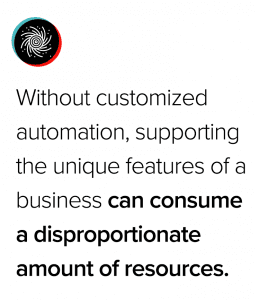
6 min read
What to do when your inefficient software is costing you more than it’s worth
What to do when your inefficient software is costing you more than it’s worth
Standing out among competitors is every company’s goal. But there is a cost to being original. While stand-out businesses tend to set the bar with unique services or products, the time, labor, and processes that support those offerings are usually developed organically, completely customized to the people and structure of the company.
While customized offerings may represent a company’s competitive edge, they can also present challenges when trying to scale the business, especially if the company employs COTS software, or commercial off-the-shelf software, to manage their day-to-day operations. COTS software is sold ready-made, offering the exact same features and experience to all users across the board.
Common examples of off-the-shelf software include Salesforce, Quickbooks, Workday for human resources management and Procore for construction management. Off-the-shelf software is a common alternative to custom software, which is built to fit.
>> Find out how to leverage the power of your existing software with legacy modernization.
Businesses that run their operations using an off-the-shelf software program are often forced to supplement their automated processes with manual labor because the software doesn’t cover the areas of their business where they are providing a product or service that’s unique to their industry.
Maintaining an ad hoc set of business procedures to make up for the gaps in off-the-shelf software can work for some companies. But how much money are they losing over the years because of their inefficient software?
Let’s look at our case study on TicketCity for an example of how an inefficient software system can present problems for a company’s growth. TicketCity is a leading online retailer of tickets for concerts, theater productions, and sporting events. Years ago, the company’s network of brokers and venues exploded rapidly, and TicketCity was struggling to process new and updated ticketing information through its inventory management system in real time.
One of TicketCity’s stand-out qualities has always been its customer service. But because of the system’s delays, they were forced to develop labor-intensive procedures to correct the system’s errors and take care of related customer service challenges. Account managers began to spend more and more time on issues stemming from their software’s shortcomings.
How much money did TicketCity lose in the form of missed sales opportunities and the labor involved in addressing compounding customer service issues? How much is your company losing due to similar gaps in your software? What’s more, how much could you be saving?
Weighing the cost of custom software
When a company chooses off-the-shelf software for its convenience and short-term savings, there are often inefficiency costs associated with that decision. These long-term costs in the form of expended resources can accumulate, eventually inhibiting company growth substantially.
Now, it’s a well-known fact that custom software is more expensive to purchase than off-the-shelf software. And that makes sense. At Praxent, our clients pay to have a team of expert software developers, designers, and architects at their disposal to see their vision through from beginning to end. They can be as picky as they want. With off-the-shelf software, what you see is what you get. Your business adapts to the technology, not the other way around.
Let’s circle back to the concept of the cost of inefficiency to determine which solution would bring you more long-term savings. If the inefficiency costs of choosing off-the-shelf software over custom software actually exceeds the cost of building the custom software, then your choice is clear.
Calculating the Cost of Your Current System’s Inefficiency
Calculating the cost of inefficiency is highly situational. You’ll want to tailor the variables to your business, thoroughly estimating the cost of each scenario. For clear results, you’ll need to collect bids for custom software alternatives before performing these calculations.
To keep things simple, we’re going to use the example of TicketCity and look at just two expenses they incurred as a result of their inefficient software.
A = Estimated amount of lost sales
B = Cost of labor spent on handling software-related customer service challenges
C = Cost of inefficiencyA + B = C
If you add the cost of inefficiency to the up-front cost to purchase the software, you’ll get a clear picture of how much you’re really paying for your off-the-shelf solution.
C = Cost of inefficiency
D = Cost to purchase off-the-shelf software
E = Total cost incurred with off-the-shelf softwareC + D = E
Now, compare this number to what it will cost to build custom software. Is it more or less? In the case of TicketCity, the financial penalties they were paying for their off-the-shelf software far outweighed the cost of building custom software.
If your inefficiency costs are less, then you might want to keep it simple (or complicated) for now and stick with your off-the-shelf option. Just keep in mind that, if your business is likely to encounter lots of growth in the future, it may still be in your best interest to transition to a hyper-scalable business model, which would require replacing your off-the-shelf software.
If the overall cost for an off-the-shelf solution, including its inefficiency cost, is more than the cost of building custom software, then you’re well-served to choose the custom software option. You could go with your current bidder, or keep shopping around, just be aware that not all software companies are created equal. You’ll want to make sure you find a software developer who will make your investment worth it.
Schedule a call with one of our development experts. We’ll help you evaluate your options for efficient software that’s in line with your business goals.





Leave a Reply